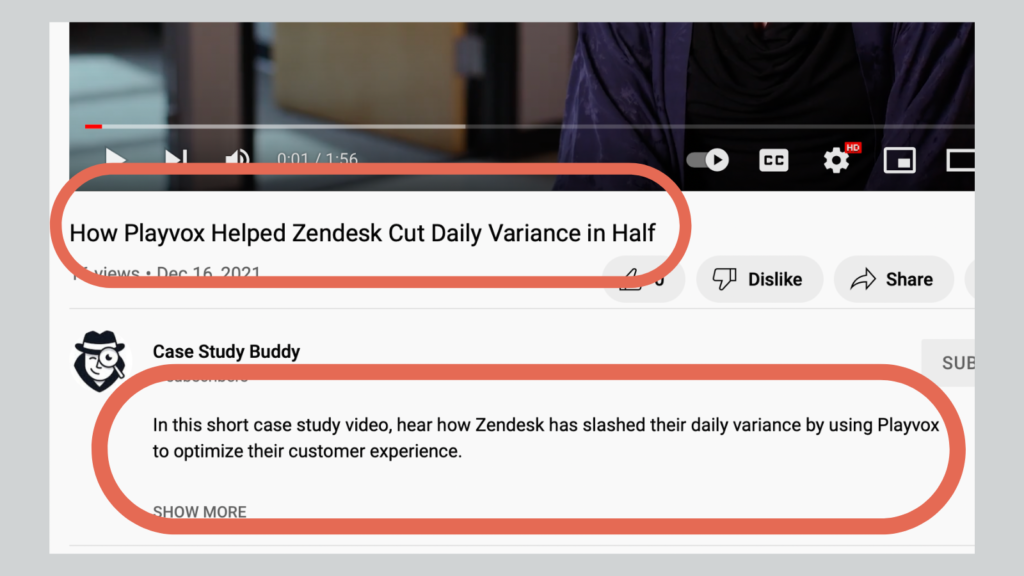It can be frustrating to create remote video testimonials and then discover that your leads watch only the first few seconds before jumping off.
Why might this happen? And what can you do about it?
The reason for a poor average watch time can vary—from how you structure your videos to how you describe them on the page.
So here are seven ways you can encourage leads to watch your remote video testimonials in their entirety:
- Deliver on the promise of the video title and description
- Choose the right video length for each use case
- Start with a bang
- Use cinematic “turns”
- Ensure picture and audio quality are high
1. Deliver on the promise of the video title and description
According to a TechSmith research study, the main reason people stop watching videos is that the videos don’t deliver the content the viewer was expecting. As they describe it:
The number-one reason people start watching a video is an interesting topic, the top reason they stopwatching is they didn’t get what they wanted…. If you want to keep people watching, your video’s title and description must match the content the video provides.
In other words, you need to make sure that the “promise” of your title and description is delivered in the video.
Thus, you need to provide a nice, descriptive title along with some descriptive on-page copy that includes the name of the customer and the nature of the success story to keep leads watching.
For example, here’s the title and description we used for one of our client’s customer testimonials (this example is from an on-location shoot):
2. Choose the right video length for each use case
Ensure that the length of your remote testimonial video is appropriate for how you intend to use it. If your video is too long for a particular use case, viewers will inevitably drop off.
So if you’re using the video top-of-funnel, you might need to keep videos short. Further down the funnel, viewers might want a longer video with more details. It all depends.
That’s why we typically create remote customer testimonials in two lengths: longer cuts that are about two minutes in duration and shorter cuts that are about 30-40 seconds.
3. Start with a bang
You need to start your video strong if you’re not going to lose people in the first few seconds.
You can do that in any number of ways, but we’ve found that two of the most successful methods are to jump right to a relatable pain point or present tangible results.
a) Relatable pain point
With this method, you go straight to a common problem that your viewer can relate to, i.e. “I was having X issue and Company A gave me the answer.” You can bet that if your viewer is experiencing the same problem, they’ll keep watching.
b) Tangible results
If you have some great success metrics to share, you can start by hinting at that number in the beginning to build anticipation, i.e. “we grew thanks to Company A,” then around the 60-75 second mark you deliver the actual number to satisfy that curiosity.
4. Use cinematic “turns”
Another way to keep your leads watching is to apply cinematic “turns.”
There’s a longstanding principle in cinema that any story should be divided into three sections, and valuable information is presented at every turn to keep viewers interested and engaged. In cinema, this means a turn at the 30-, 60-, and 90-minute marks (approximately).
In the case of a two-minute customer video testimonial, that means you should present something particularly engaging every 30 seconds or so.
Naturally, you can bend this rule depending on your video. But the more you can adhere to it, the better the chance you’ll have of people watching through to the end.
5. Ensure picture and audio quality are high
Naturally, if your picture or audio is of poor quality, viewers are less likely to stick around to the end. It would take a highly motivated lead to sit through a video that takes a lot of brain processing power to get through.
That’s why we ship equipment to our client’s customers in advance of the shoot (which they can keep!) and conduct a pre-shoot test to make sure that customers looks and sounds their best.
Remember: Watch-time metrics aren’t the end goal
While it’s easy to get fixated on video metrics, such watch time, improving those metrics isn’t the end goal. The end goal is to move your leads further down your sales and marketing funnel.
Sometimes watching an entire customer video testimonial is what’s needed.
But sometimes, all it takes is a few seconds of watch time—or scrolling through a long, impressive playlist of video testimonials—to help convince leads you’re the right solution for them.
Need help with your remote video testimonials?
We help our clients create remote video testimonials—from strategy to signed-off deliverables—that deliver what they promise and hold the attention of leads.
Contact us to learn more about all of our video testimonial formats.
